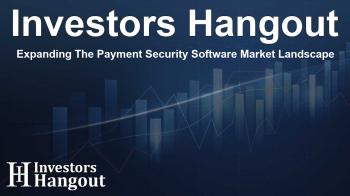Expanding The Payment Security Software Market Landscape

Understanding the Payment Security Software Market
The Payment Security Software Market is experiencing remarkable growth as the world witnesses an unprecedented increase in digital transactions. This significant upward trend is fueled by the tireless expansion of e-commerce and the subsequent demand for enhanced security solutions. With rapid advances in technology, consumers are increasingly flocking to online platforms for their purchasing needs, heightening the importance of safeguarding payment processes.
Current Market Value and Projections
As of now, the payment security software market was valued at USD 27.76 billion and is anticipated to surge to USD 94.53 billion by 2032. This growth rate translates to a compound annual growth rate (CAGR) of 14.74% from 2024 to 2032. Such a projection signals a robust and resilient market, with advancements in technology fueling a need for better security measures.
Key Growth Drivers
The primary catalysts for growth in this sector underscore the rising concerns over cybercrime, as the sheer volume of digital transactions skyrockets. For instance, the total value of digital payments in significant markets is projected to reach trillions, prompting businesses to invest in robust security measures. Companies are turning to solutions like encryption, tokenization, and multi-factor authentication to secure sensitive information and maintain customer trust.
The Rising Demand for Security Solutions
The increasing reliance on mobile payments, online banking, and the push for compliance with strict regulatory frameworks has further accelerated the demand for sophisticated payment security software. A notable example is Visa acquiring Featurespace to enhance fraud protection, showcasing how companies are continuously evolving their strategies to combat potential threats.
Technological Innovations Shaping the Future
Looking towards the future, the integration of artificial intelligence (AI) and machine learning within payment security software is a monumental trend. These technologies promise to deliver advanced fraud detection capabilities, making them indispensable in the fast-evolving digital landscape. Furthermore, the rise of mobile commerce presents ample opportunities for innovation, as seen with Mastercard’s recent initiatives to implement biometric authentication and passwordless payments.
Key Players in the Market
The competition within this market is fierce, with several key players continuously striving to enhance their offerings. Major players include MagTek, PayPal, CyberSource, and Mastercard, among others, who are progressively innovating to deliver cutting-edge solutions. Their ongoing research and development efforts not only fuel competition but also drive the overall advancement of the payment security sector.
Regional Dynamics of Payment Security Solutions
Regionally, North America leads the market with a significant share in terms of revenue, primarily due to its robust technological framework and increased adoption of digital payment platforms. However, the Asia Pacific segment is on the verge of becoming the fastest-growing region, bolstered by the increasing penetration of smartphones and internet access, which facilitate a surge in online transactions.
Industry Trends and Projections
Various segments within the market demonstrate diverse growth trajectories. For instance, the services segment is expected to grow at a brisk CAGR of approximately 16.52%, fueled by a rising need for customized support and maintenance services as organizations address the complexities of safeguarding their payment systems. Additionally, the banking, financial services, and insurance (BFSI) sectors remain significant contributors to market revenue, constituting almost 27% of the total market.
Challenges and Future Considerations
While the payment security software market is on a pathway to remarkable growth, it is not without challenges. Businesses face mounting pressure to stay ahead of evolving cyber threats and compliance requirements. Thus, organizations must prioritize investing in robust security solutions and continuous training to ensure their operations can handle the complexities of digital payments seamlessly. The future landscape appears bright, given the ongoing commitment to innovation and technology in the sector.
Frequently Asked Questions
What is the projected value of the payment security software market by 2032?
The payment security software market is projected to reach USD 94.53 billion by 2032.
What factors are driving the growth of payment security software?
Key drivers include the increase in digital transactions, e-commerce expansion, and the need for advanced fraud prevention solutions.
Which regions are leading in the payment security software market?
North America currently leads, while the Asia Pacific region is projected to exhibit the fastest growth.
Who are the major players in the payment security software industry?
Major companies include MagTek, PayPal, CyberSource, and Mastercard among others.
What technologies are shaping the future of payment security?
AI and machine learning technologies are expected to significantly enhance fraud detection and overall security solutions.
About Investors Hangout
Investors Hangout is a leading online stock forum for financial discussion and learning, offering a wide range of free tools and resources. It draws in traders of all levels, who exchange market knowledge, investigate trading tactics, and keep an eye on industry developments in real time. Featuring financial articles, stock message boards, quotes, charts, company profiles, and live news updates. Through cooperative learning and a wealth of informational resources, it helps users from novices creating their first portfolios to experts honing their techniques. Join Investors Hangout today: https://investorshangout.com/
Disclaimer: The content of this article is solely for general informational purposes only; it does not represent legal, financial, or investment advice. Investors Hangout does not offer financial advice; the author is not a licensed financial advisor. Consult a qualified advisor before making any financial or investment decisions based on this article. The author's interpretation of publicly available data presented here; as a result, they should not be taken as advice to purchase, sell, or hold any securities mentioned or any other investments. If any of the material offered here is inaccurate, please contact us for corrections.
